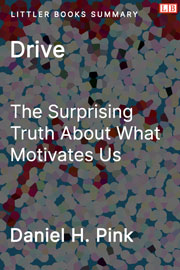Book Description
A challenge to traditional notions of motivation through extrinsic rewards, instead arguing for the importance of intrinsic motivation.
If You Just Remember One Thing
Coming soon.
Bullet Point Summary and Quotes
- In 1949, psychologist Harry Harlow conducted an experiment where monkeys solved puzzles without any external rewards, surprising him. This hinted at a third type of motivation -- intrinsic motivation. The discovery of intrinsic motivation represents an evolution in understanding what motivates human behavior.
- The three types of motivations are:
- Biological drive to survive
- External/extrinsic incentives (rewards and punishments)
- Intrinsic motivation
- Extrinsic motivation cannot inspire curiosity and innovation. People only driven by rewards and punishments
will typically put in the minimal effort required to get the reward or avoid the punishment.
- “The problem with making an extrinsic reward the only destination that matters is that some people will choose the quickest route there, even if it means taking the low road. Indeed, most of the scandals and misbehavior that have seemed endemic to modern life involve shortcuts.”
- Appealing to intrinsic motivation can unleash people's full potential for creative and challenging work.
- “The science shows that the secret to high performance isn't our biological drive or our reward-and-punishment drive, but our third drive -- our deep-seated desire to direct our own lives, to extend and expand our abilities, and to make a contribution.”
- Intrinsically motivated people take responsibility and don't need constant direction or rewards because they enjoy the work itself and become immersed in activities they find inherently interesting or meaningful.
- “For artists, scientists, inventors, schoolchildren, and the rest of us, intrinsic motivation -- the drive to do something because it is interesting, challenging, and absorbing -- is essential for high levels of creativity.”
- Despite recognizing the power of intrinsic motivation, the workplace often neglects it in favor of monetary incentives.
- In 1995, people would have thought choosing the crowdsourced, unpaid Wikipedia over Microsoft's professionally written, big budgeted, Encarta encyclopedia was insane, yet Wikipedia became massively successful with millions of articles written by volunteers purely for the enjoyment of the work itself, while Encarta became discontinued.
- Children exemplify true masters of intrinsic motivation through their natural curiosity and drive to learn and explore without external rewards. However, as we grow up, society conditions us to require extrinsic motivations like praise, grades, and paychecks, gradually eroding our intrinsic motivation.
- Extrinsic motivation undermines performance on creative, non-routine tasks. The overemphasis on extrinsic
motivation can backfire.
- In one experiment participants were asked to solve a creative problem of attaching a candle on the wall so the wax doesn't drip on the table. One group was incentivized with money (faster = more money), the other group was not. On average, the solves took the incentivized group nearly three and a half minutes longer.
- In an experiment with potential blood donors, offering a small monetary payment actually decreased the number of donors by almost half compared to a voluntary, unpaid group.
- “People use rewards expecting to gain the benefit of increasing another person's motivation and behavior, but in so doing, they often incur the unintentional and hidden cost of undermining that person's intrinsic motivation toward the activity.”
- “Rewards do not undermine people's intrinsic motivation for dull tasks because there is little or no intrinsic motivation to be undermined.”
- To unleash true motivation and engagement, organizations need to provide an environment fostering mastery, autonomy, and purpose.
- Mastery: Allow people the freedom to pursue continual self-improvement in their work.
- Providing opportunities for mastery, rather than simply adherence to rules, can unleash people's inner drive, creativity and commitment to their work.
- Employees can enter a state of flow -- complete immersion and focus -- when tackling appropriately challenging tasks that allow them to enhance their skills and strive for perfection.
- “People can have two different mindsets… Those with a ‘fixed mindset' believe that their talents and abilities are carved in stone. Those with a ‘growth mindset' believe that their talents and abilities can be developed. Fixed mindsets see every encounter as a test of their worthiness. Growth mindsets see the same encounters as opportunities to improve.”
- Research shows more than 50% of employees are not engaged at work and nearly 20% are actively disengaged.
- Autonomy: Allow people to make their own decisions about how they work.
- Meddius doesn't have office hours. Employees just need to get their work done. As a result, employees worried less about logistics related to scheduling and were less likely to jump to another job.
- Google allowed employees 20% of their time to work on whatever they wanted. This resulted in products like Gmail, Orkut, and Google Translate.
- Providing autonomy cultivates self-determination, engagement, and greater achievement potential while reducing burnout.
- “The ultimate freedom for creative groups is the freedom to experiment with new ideas. Some skeptics insist that innovation is expensive. In the long run, innovation is cheap. Mediocrity is expensive -- and autonomy can be the antidote.”
- “Management isn't about walking around and seeing if people are in their offices. It's about creating conditions for people to do their best work.”
- Purpose: Make the work meaningful.
- Studies show people who pursue meaningful goals like personal growth and helping others report greater life satisfaction than those solely chasing money or fame.
- Studies show that allowing employees to positively impact society, whether through charitable work, community outreach, or providing valuable services and products, can improve employee welfare and satisfaction.
- “Being a professional is doing the things you love to do, on the days you don't feel like doing them.” - Julius Erving
Drive: Resources
- Download this summary and 173+ other top nonfiction book summaries in one book (PDF, eBook, DOCX)
- Buy the book
